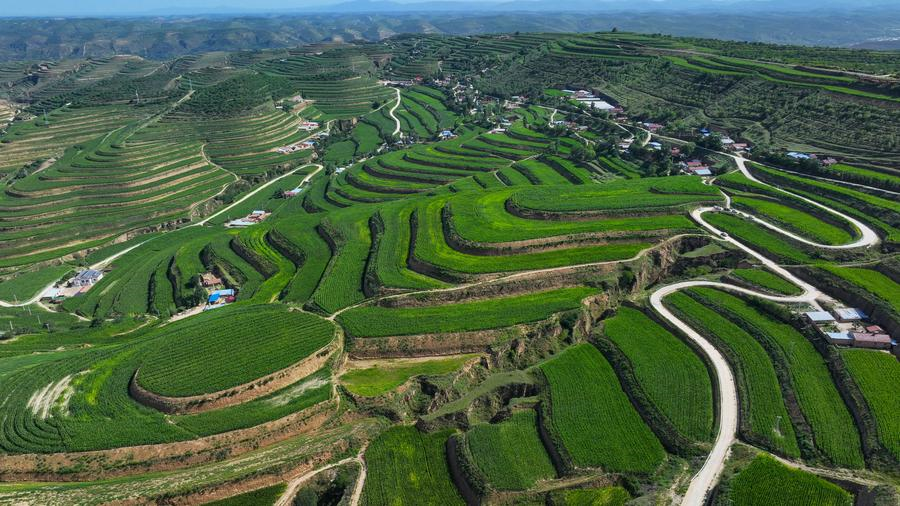Rural Roads Investment Serve China’s Development

An aerial drone photo taken on July 25, 2024 shows rural roads connecting fields and villages in Pengyang County, Guyuan City, northwest China's Ningxia Hui Autonomous Region. (Xinhua/Feng Kaihua)
The State Council Information Office recently issued a white paper on China’s rural road development. Titled ‘‘China’s Rural Roads in the New Era,’’ the white paper outlines the nation’s achievements and vision for rural development in the new era – and shares China’s experience. According to the white paper, over the last decade, upgraded and newly-built rural roads added up to more than 2.5 million km. By the end of 2023 the total length of rural roads reached 4.6 million km, a 21.7 percent expansion compared to 2013, enough to circle the equator 115 times. Further details show a total of 700,000 km of county roads, 1.24 million km of township roads and 2.66 million km of village roads were built. There were a total of 530,000 highway bridges and 2,222 tunnels in rural areas. Ultimately, the upgraded and newly-constructed rural roads help build a rural transport infrastructure network, where county roads connect rural and urban areas, township roads crisscross, and village roads facilitate travel between households and farmland.
Considered the primary, if not the sole transport channel in China’s rural communities, rural roads play a critical role in the nation’s development. As the Chinese saying goes: ‘‘if you want to be wealthy, build roads first’’. Guided by this understanding, the Chinese government, committed to meeting the people’s growing desire for a better life has spared no effort in financing the development of rural roads. Over the past decade, a cumulative investment of RMB4.3trillion and RMB1.1 trillion has been invested in rural roads fixed assets and maintenance, respectively. Benefiting from diverse market-based financing mechanisms in rural road development, the government contributed approximately 80 percent of the total funding in either category – expediting the development of good-quality rural roads. Since the 18th National Congress of the CPC in 2012 China’s rural roads development has transitioned into a new phase. Under the leadership of President Xi Jinping, China has witnessed high-quality development of rural roads mainly underpinned by institutional innovation, pertinent policies, systematic planning and targeted policy implementation. Over the period, the upgraded and newly-built rural roads have help provide strong support for the comprehensive development of the rural economy and society – playing an indispensable role in laying the foundation for advancing all-round rural revitalization and rural modernization.
Guided by a people-centred philosophy of development, the Chinese government in its quest to ensure all-inclusive and sustainable development has aligned rural roads development with various national development strategies for poverty eradication, agriculture modernization, and rural modernization. From the Plan for Rural Roads Construction issued in 2005, to more recently, the Outline of Poverty Alleviation-Oriented Transport Projects in Contiguous Poverty-Stricken Areas (2011-2020) and the Outline for National Territorial Space Planning (2021-2035), – these Plans adopted by the government have guided the design of rural roads connecting industrial parks and tourist destinations, and strengthened the impact of rural roads on cultural and tourist resources and distinctive local businesses. Benefitting from these Plans, China in recent decades has witnessed enhanced urban-rural integration – contributing to accelerate rural economic development.
Data released by the National Bureau of Statistics (NBS) show in 2023 per capita disposable income for China’s rural residents grew at a faster pace than that of their counterparts in the city. Rural per capita disposable income in 2023 reached 21,691 yuan, up 7.7 percent in nominal terms and 7.6 percent in real terms. Thanks to national development strategies for poverty alleviation, agriculture modernization and rural revitalization which are aligned with rural roads development, over the past decade, average annual per capita disposable income of rural households has witnessed steady growth, rising from 9,430 yuan in 2013 to 20,133 yuan in 2022. For example, to shore up weaknesses and eliminate bottlenecks in rural logistics, which is essential for enhancing urban-rural integration, according to the recently issued white paper, local authorities have put in place extensive rural passenger transport networks that provide full coverage and connect urban and rural areas, with county seats as hubs, towns and townships as nodes, and administrative villages as terminuses.
In the past decade, more than 1,100 towns and townships and 45,000 administrative villages have been newly integrated into the networks. As a result, all towns, townships and administrative villages where conditions allow have access to bus services. Ultimately, efforts to coordinate logistics development in rural and urban areas in an attempt to foster the urban-rural two-way flow of goods and services has supported various rural industries including rural tourism, and paved way for rural-ecommerce and express delivery, which has injected new momentum into agriculture modernization and rural revitalization. In November this year, the State Post Bureau of China announced the nation has established over 337, 800 parcel delivery stations in villages, marking a significant milestone in rural logistics development. Thanks to the extensive rural road networks connected to cities, the Chinese economy and society in the last decade has witnessed enhanced two-way flow of people, information, goods and services between rural and urban areas, – contributing to stimulate production and consumption in the Chinese economy.
About the author: Alexander Ayertey Odonkor is the founder and leading expert at the Ghana Centre for China Studies, Africa’s preeminent and most comprehensive platform exclusively dedicated to authoritative interpretation of China’s domestic and foreign policies.
Production credits: This commentary is produced by the Ghana Centre for China Studies (GCCS), and published in a joint collaboration with the China Internet Information Center.
At the Ghana Centre for China Studies we eschew specific policy positions. All positions and opinions expressed in this publication are solely those of the author (s).